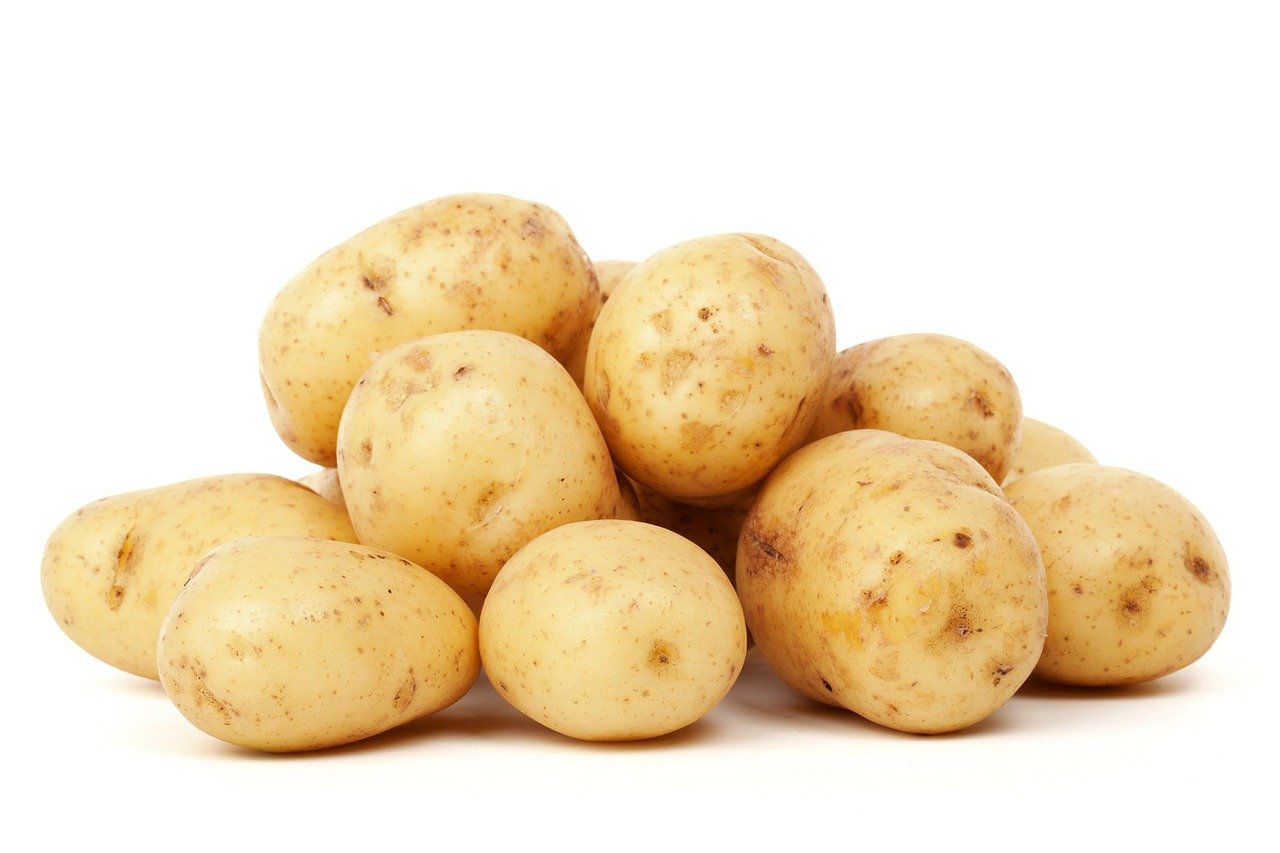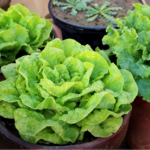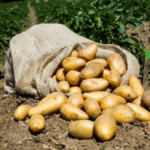White potatoes also known as Irish white potatoes or Irish potatoes are an all-purpose potato type with typically white, thin skin and white flesh. White potatoes have a medium-starch content, lower than the equally popular fresh market Russet cultivar. The Irish potato is good for domestic culinary recipe preparations such as soups, roasting, boiling, steaming and mashing. It has a creamy dense texture and a mild flavor that bends towards sweetness. At a commercial level, the potato is good for chipping.
Table of Contents
What are White Potatoes?
White potatoes are one of thousands of potato cultivars available around the world of the species Solanum tuberosum belonging to the nightshade family Solanaceae. Family membership includes other familiar vegetables such as peppers and eggplants.
The white potato is categorized into one of the three major potato divisions namely Round Whites, Russets, and Reds according to Oregon State University College of Agricultural Sciences. Newly developed tuber varieties not fitting into this categorization are often identified as “Specialty” and “Gourmet” potato types according to the University. We have in mind here, yellow and purple skinned and flesh varieties some of which are used to make purple potato chips (example)
White Potato Characteristics
The following table summarizes the most common and identifiable characteristics of white potatoes.
| Botanical name – Solanum tuberosum |
| Scientific family – Solanaceae, Nightshade |
| Group – Vegetable, carbohydrate group |
| Origins – Ireland (18th century Europe) |
| Shape – Round, oval shape, oblong, long |
| Skin – Thin, white, light tan, smooth |
| Flesh – White flesh |
| Starch level – Medium, lower than Russet |
| Flavor – Mildly sweet |
| Uses – Soups, stews, roasting, boiling, steaming, mashing, chips |
| Planting – Cool-season |
| Soils – Well draining, acidic, slightly acidic |
| Conditions – Full sun |
| Harvest – 90 to 120 days |
| Diseases – Early blight, late blight, common scab etc. |
White Potato Origins
The white potato originated in 18th century Europe following the arrival of the potato to Europe from South America in the 16th century. In the 17th century, Central Europe cultivated a yellow-fleshed potato variety with a white-yellowish skin which became known as the Dutch yellow potato. Between late 18th century and early 19th century, the potato arrived in the British Isles from whence the white fleshed and white-skinned or red-skinned potato cultivars were developed.
The Great Famine of 1845 in Ireland also known as the Irish Potato Famine caused by late blight, a potato disease, resulted in human population falling by between 20% and 25% due to starvation and immigration. Many Irish people emigrated to North America bringing with them the Irish White Potato. By this means, the white potato which is also known as the Irish White Potato arrived in the United States in the 19th century where it became very popular.
Potato Kitchen Utensils
Potatoes are an important vegetable which is a source of high value nutrition (see nutrition section). How potatoes are stored and cooked matters and contributes to the type of health impact they bring to the table. Since potatoes remain an important ingredient in any home kitchen at any given time, certain utensils become handy for the best potato cooking and eating experience. Below are some very useful and recommended kitchen utensils applicable when working with all types of potatoes.
- Potato air fryer
- Potato cooker bag
- Potato casserole dish
- Potato masher
- Hand potato peeler
- Electric potato peeler
- Potato ricer
- Potato crinkle cutter
- Potato storage canister
- Potato storage bin
- Potato scrubber brush
- Home potato grow bag
White Potato vs Russet Potato
Although the Irish White potato first appeared in the United States, the Russet potato soon followed. A comparison of White potato and Russet potato, two of America’s most popular potato cultivars, reveals some shared similarities as well as some sharp differences. One of the noticeable similarities is that both potatoes have white flesh and are rounded in as much as some Russets are oblong. However, White Irish potato has a white, thin skin while Russet has a thick, rough, dark brown skin with very dry flesh.
Furthermore, Russet potatoes are high starch potatoes which fall into the Starchy category while White potatoes have significant starch content but at a lower level than the Russet cultivar, landing in the All-purpose potato category.
Nonetheless, the pair are ideal for some shared common culinary applications. Both are perfect for roasting, baking, chipping and mashing. However, concerning baking, apart from Idaho potato, Russet’s other name is the baking potato. This is the iconic North American potato for fluffy baked potatoes. It is the king of baking potatoes. Ahead of picking White potatoes, many people would pick Russet when considering a scrumptious baked potato dish.
Compared with Russet, White potato is the typical boiling and chunky soup potato. You would, however, not get the same with Russet which is best suited for puree type soups due to its inability to remain intact as required when making chunky potato soups. This is because Russet disintegrates in soups for being too absorbent.
Historically speaking, while the White potato originated in Ireland, Russet originated in Massachusetts, United States where it was developed by Luther Burbank in the 1870s. This particular potato is known as the Russet Burbank which is the original Russet potato.
Today, there are dozens and dozens of Russet potato varieties with some such as the Classic Russet, a 1995 cross between Blazer Russet and Summit Russet, having been released as recently as 2009 according to the American Journal of Potato Research.
After all has been said, White potato vs Russet potato comparison reveals that the two cultivars have some things in common and also some marked differences. All in all, the two are distinct potato types with distinct strengths ideal for certain respective culinary applications.
White Potato vs Red Potato
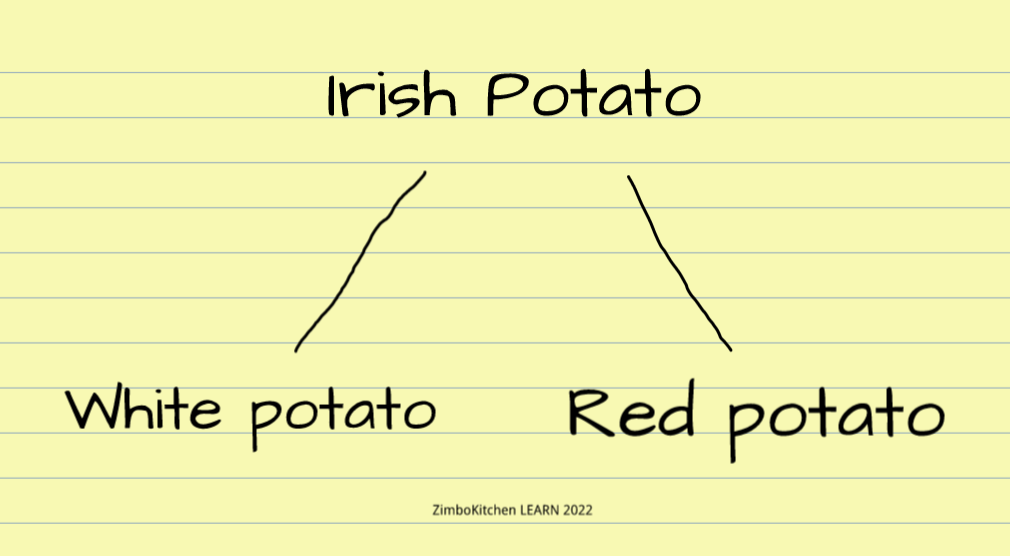
A comparison of White potatoes and Red potatoes is closer to home and soon reveals that the two potato cultivars are of the same lineage as illustrated above. Both potatoes have origins in Ireland. According to Texas A&M AgriLife Extension Service, White potatoes and Red potatoes are the most common types of Irish Potatoes.
Texas A&M AgriLife further states that White potato has superior cooking qualities compared to the Red potato. However, being of the same root and lineage, red potatoes possess some strikingly similar traits to the White potato. For example, as much as they have red skin, red potatoes also have thin skin and white flesh just as the emblematic White potato.
Furthermore, red potatoes have a similarly round to oblong shape as one would expect of the White Irish potato. Nonetheless, red potatoes tend to be of medium size whilst the White potatoes can range from small to large.
Compared to the White potato which is categorized as an All-purpose potato, red potato is more of a Waxy potato which represents another point of difference. Red potatoes do well in salads and their red color is a bonus when one is particularly interested in creating a colorful dish.
The starch content is lower but the sugar and moisture content is higher in the red potatoes compared to White potatoes. Nonetheless, both potatoes share in practical recipe applications such as mashing, salads, soups, stews and roasting. Due to this closeness, they can be successfully used as alternatives to each other when cooking.
Baby White Potatoes
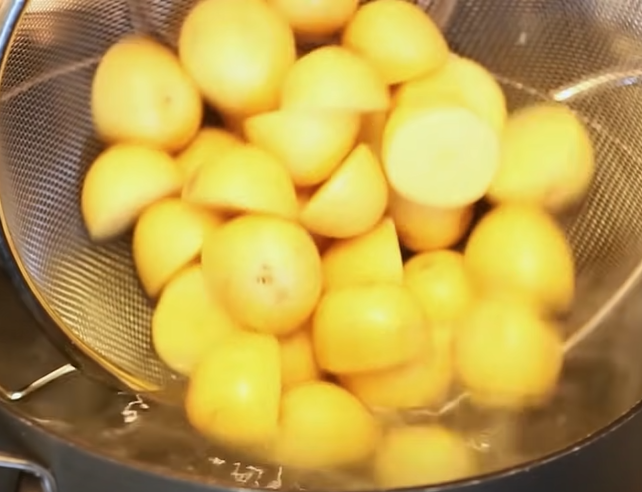
Baby White potatoes are interesting mini potatoes that are intentionally grown to be fresh, tasty and of a certain size and shape. They are also called new potatoes or small-sized potatoes. For comparison, baby potatoes can be as small as strawberries in size.
Commercial producers are often guided by market interest in determining the size. The White Irish baby potato is not a potato variety of the White potato but rather a specialty potato that is manipulated to become a baby potato through planting methods and harvest timing.
As much as some varieties produce better results than others when turned into baby potatoes, baby potatoes are not about variety but growing methods used to produce them (see growing section).
Although we have Baby White potatoes, small-sized potatoes can be produced from just about any existing potato variety. For this reason, we have both white and red baby potatoes on the market.
White baby potatoes have a variety of recipe applications. The fact that they are small, tender and with almost no blemish at harvest also means they are often consumed whole with the skin on. This also means less labor to scrub or peel them and quicker recipe production in the kitchen.
Baby White Potato Uses
The following are some uses of baby White potatoes.
| Lightly smashed – baby potatoes can be boiled and then slightly crushed or mashed with a fork with the skin on for use in salads. They have a light subtle flavor which works wonders for salads. Once crushed they will look like scrambled eggs and can also be served as a starch with fish or grilled steak. |
| Fried – baby potatoes can be sliced and fried in oil in an open pan and served for breakfast, lunch or dinner. |
| Curries – not all baby potatoes are suitable to be included in a one pot curry. However, baby White potatoes will do well in this application as white potatoes themselves are good in stews. |
| Roast – this is one of the most popular applications of new potatoes. The potatoes can be roasted by themselves or alongside meats as a starch accompaniment. The potatoes tend to produce a scrumptious browning when roasted. |
| Stews – if you can use baby White potatoes in curries, you can also surely stew them. This is also a popular use of baby potatoes in all kinds of stews. White Irish potatoes have what it takes to go along and produce a great stew without falling apart and turning into a puree as would potentially happen with the Russet. |
White Potatoes Nutrition
White potatoes are an important source of nutrients. They contain carbohydrates, dietary fiber, and resistant starch. Resistant starch is useful for gut health and weight management. In this regard, in 2020, a study published in the journal Nutrients determined that White potatoes beneficially suppressed appetite without negative repercussions.
As far as starch content is concerned, Texas A&M AgriLife Extension Service states that White Irish potatoes contain 2 percent protein and 18 percent starch making them an inexpensive source of dietary carbohydrates.
In addition, the White Irish potato provides a concentrated source of vitamin C and potassium according to the journal Advances in Nutrition. Vitamin C is crucial in the growth, development and healing of all body tissues. On the other hand, potassium is a critical mineral which plays a role in the regulation of fluid balance, muscle contractions and nerve signals in the human body.
Advances in Nutrition further notes that dietary fiber and potassium appeared in the 2010 Dietary Guidelines for Americans as nutrients of concern. Nutrients of concern often indicate nutrients that are under-consumed by the population. White vegetables such as white eggplants, onions, mushrooms and White potatoes provide important dietary nutrients and are to be included in the home diet.
Many are aware that potatoes have received a good measure of maligning on the basis of their often conjectured link to obesity. Indeed, when many people consider potatoes what is most prominent in thought are greasy deep fried fast food chips. However, in of itself the White potato is beneficial to human health as scientific evidence presented supports. However, the downside associated with potatoes is a matter of how individuals choose to prepare and consume the spuds.
Even so, according to Oregon State University, an average-size baked potato only has 90 to 100 calories which is a little higher than half a cup of cottage cheese or an apple. Additionally, the protein found in potatoes presents a well-balanced contingent of indispensable amino acids and is among the best one could find in vegetables. Amino acids’ contribution to human health include energy production, regulation of digestion, immune system support and hormone production.
After all has been said and done, the point that available scientific evidence makes is that White potato’s nutritional contribution to human health is of high value and should not be clouded by the long standing bad rap given to the vegetable. White potatoes are thus a legitimate source of dietary nutrition.
White Potato Varieties
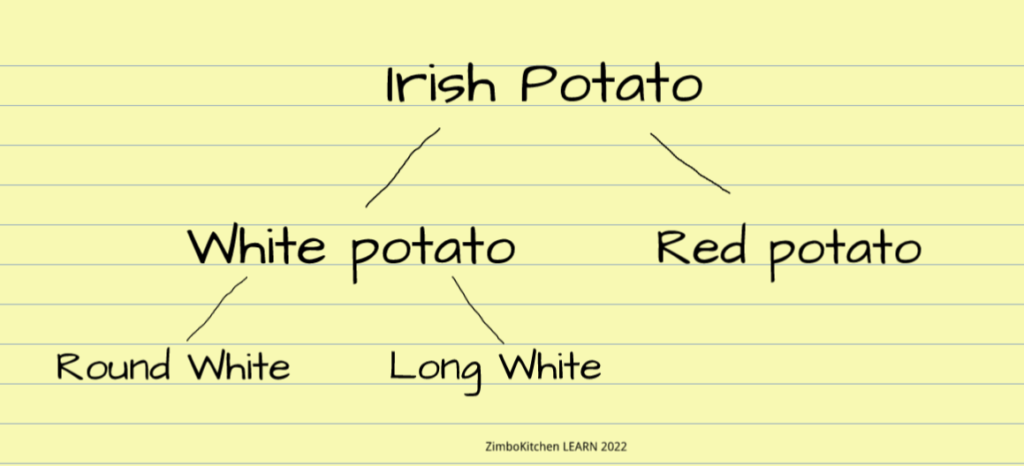
While there may be thousands of potato varieties, there are a couple of White potato cultivars. The two main White Irish potato cultivars are Round white and Long white with a lineage as illustrated above. The Round white is perhaps the most common type of White potato and has been the one most discussed in this article including its particulars. Its varieties include Atlantic, Kennebec and Superior potatoes among others.
The Long white potato cultivar differs primarily in shape. It has an elongated shape but maintains a thin skin and medium starch level in similar fashion as the Round white. It also shares similar recipe applications as those of the Round white i.e. soups, roasting, boiling, steaming and mashing. The Long white has been cultivated in California in abundance for a very long time.
According to the Madera Tribune of 15 February 1967, the Long white potato appears to have originated in New York State towards the end of the 19th century. Its earlier name was the America Giant. It later became known as the Wisconsin Pride or White Rose before growers and transporters began calling it the Long White. Its staggering success in California finally led to the name California Long White. Today, White Rose and Long White are the predominant names used to refer to this potato cultivar which remains a success.
Overall, potato varieties be it White potatoes, red potatoes or other potato types differ based on “yield, skin and flesh color, tuber shape and eye depth, time of maturity, disease and pest resistance, carbohydrate composition, usage potential, dormancy and storability” according to Potato Variety Selection information as provided by Oregon State University.
In addition, University of Idaho gives interesting insight into potato variety development. According to the University, potato variety breeding is a strenuous evaluation process which takes up to 15 years involving hundreds of tests before the potato variety is released for widespread cultivation.
Round White Potato Varieties
The following are some selected Round white potato varieties as available on the North American market.
| Atlantic White potato variety – this is a 1976 high yielding White Irish potato which is primarily used for making potato chips. It produces round uniform tubers with very low sugar at harvest but which tend to increase with long term storage especially under cool temperatures of below 50°F or 10°C. |
| Kennebec potato variety – this is a Round White potato 1948 hybrid variety that is very popular in the United States. It also makes potato chips but is used by home cooks in a variety of recipes involving frying, baking, mashing and roasting. The potato shines most when frying. Although a White potato and unlike other White potatoes with white skin and white flesh, it has brownish skin and white flesh. |
| Superior potato variety – this is a 1962 University of Wisconsin potato variety. This is a hybrid variety crossed from a parent of the forgoing Kennebec White potato variety. This is a white skin, white flesh White potato of an oval to round shape which is also used for chipping. In the home setting, it is excellent as a mashed, baked or chipped potato. |
| La Chipper potato variety – this is yet another White potato variety that was introduced in 1962. It is a round, elongated tuber All-purpose potato. It can also be processed into chips in a similar fashion as the aforementioned varieties. La Chipper has white skin and intensely white flesh. |
White Potatoes Recipes
Although also fermented into alcohol, the primary application of White potatoes is culinary recipes. Whites potatoes cab be paired with a variety of meats as fries, mashed potatoes and so on. Like all potatoes, White potato is first cooked before consumption. The following is a collection of delicious White potato recipes to try out. Our list of utensils shared earlier above become handy in the making of these tasty potato recipes.
Garlic Roasted White Irish Potato Recipe
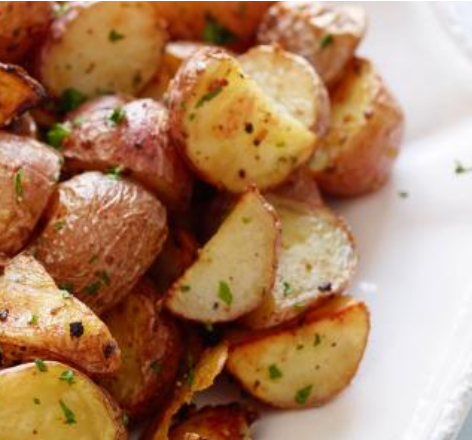
This is a roast potato recipe, so White Irish potatoes perfectly feel at home in this recipe which will see the potatoes roast for up to 1 hour. It is an easy to do recipe with only 10 minutes required to get all the ingredients ready before they are spread on an oven tray and left to spend the bulk of the time in the oven roasting
Apart from White potatoes, other ingredients required are olive oil, garlic, fresh parsley and ground back pepper among others. This dish serves 8 and can be served as an accompaniment to a protein. View Recipe.
Roasted Mini Potatoes Recipe
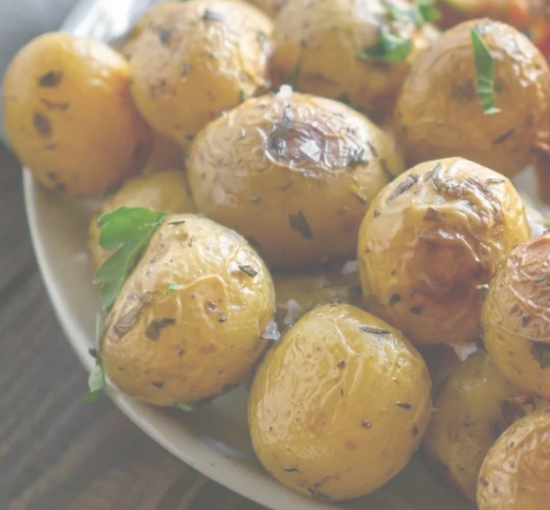
This is yet another roasting recipe save that this time around we are roasting baby potatoes. The recipe calls for one pound or 500 grams baby White potatoes, olive oil, parsley, thyme and garlic. The herbs in this recipe can be used fresh or dried. The new potatoes are slowly roasted, bringing out much flavor and at the same time preventing them from drying out on the inside.
The outward look of the final product will be a scrumptiously crispy finishing. The potatoes can be paired with pork chops, or other protein. View Recipe.
Classic White Potato Salad Recipe
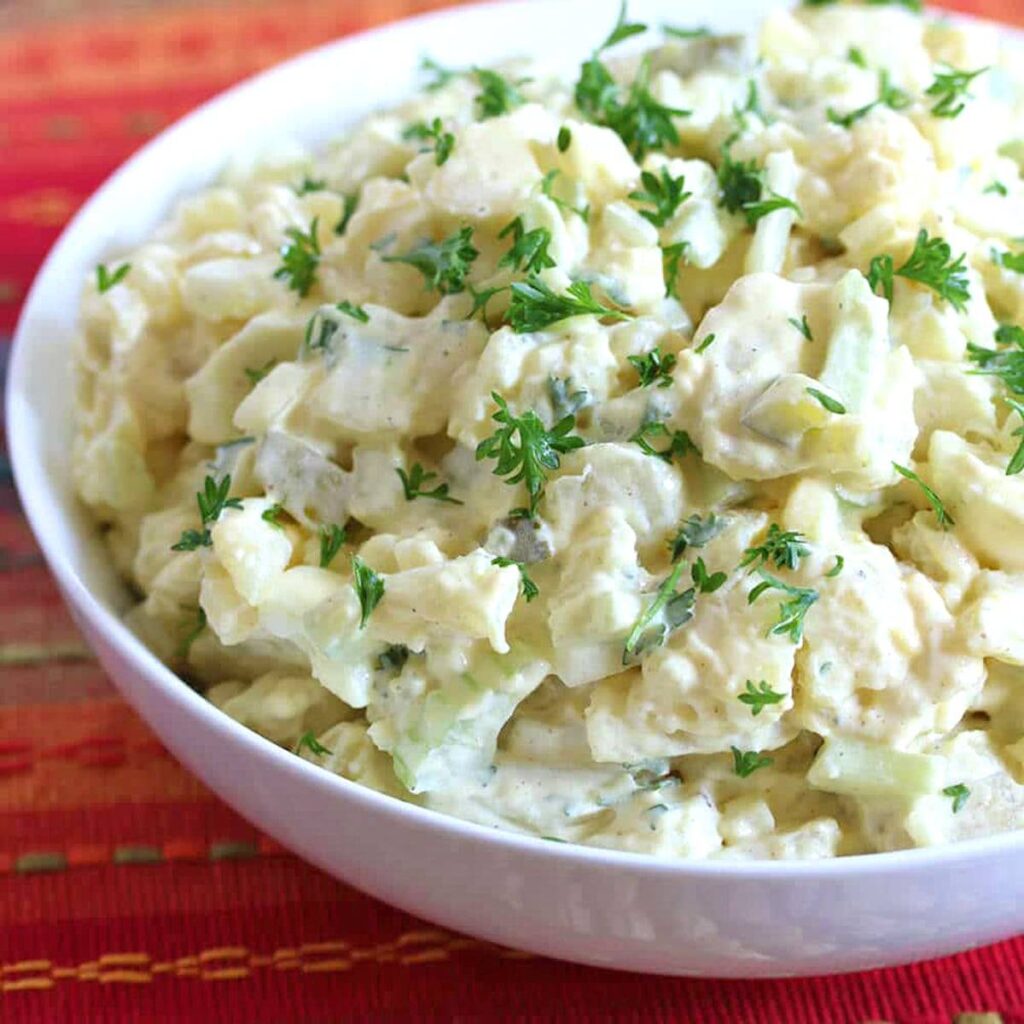
This recipe calls for yellow potatoes. These can easily be replaced with White potatoes which are also perfectly suitable for making delicious salads. The potatoes are first washed and then boiled for a time with their skins on before they are peeled and then sliced.
The classic potato salad coming out of this recipe will require a minimum refrigeration time of 2 hours but will taste even better when refrigerated longer, say overnight. The salad will go with a mayo sauce which is made using mayonnaise, brown mustard, white vinegar and fresh parsley among other ingredients. This recipe serves 6, takes 15 minutes to prepare and at least 2 hours to sit for chilling. View Recipe.
Cucumber Potato Salad Recipe
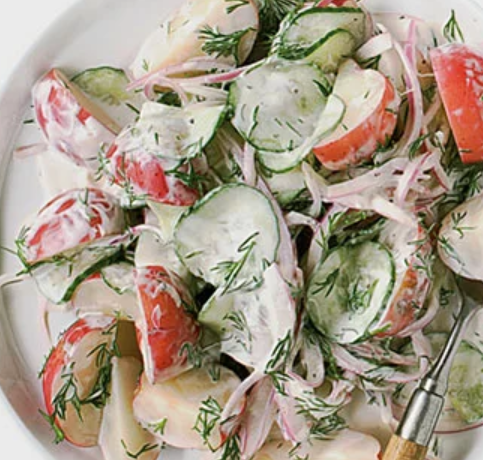
This recipe originally calls for red-thin skinned potatoes. These can easily be replaced with White potatoes which are also thin skinned and suitable for salad making. Even more, both potatoes may be used in the same recipe if one is interested in maintaining the color injected by red potatoes into the salad.
The cucumber in this recipe will be a mandoline thinly sliced burpless cucumber. Other suitable cucumbers will be Armenian, Persian and Lemon cucumbers which are also burpless and of a thin edible skin. Additional recipe ingredients are olive oil mayonnaise or regular mayonnaise, fresh dill, and red wine vinegar among others. This recipe takes 30 minutes to make and serves 8. View Recipe.
Baby White Potato Caesar Salad Recipe
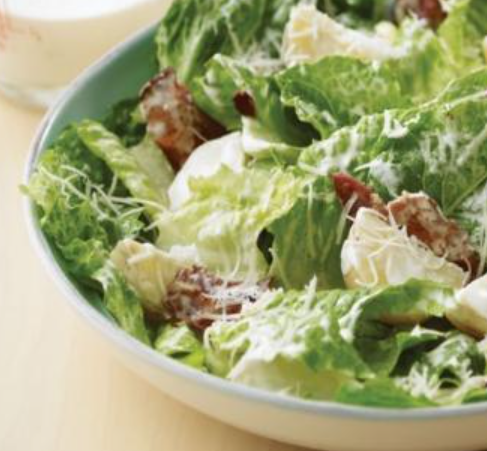
This recipe presents another opportunity to use baby white potatoes by combining them with some lettuce all covered in a scrumptious dressing. The recipe calls for Romaine lettuce. However, for color there is room to add a twist to it by using purple lettuce alongside the green lettuce.
Buttercrunch or Boston lettuce torn by hand could also be used in this recipe in place of the Romaine lettuce. Finally, if you wanted to add a tad bit of bitterness to it, frisee lettuce could also be put in the mix in the recipe. This recipe yields 6 and takes a total of 35 minutes to make. View Recipe.
Growing White Potatoes
Growing White potatoes is fundamentally similar to approaches used in growing other potato types. The potatoes can also be grown in containers or potato bags (example). The optimal conditions for successfully growing White Irish potatoes are cool conditions, full sun and a growing medium of slightly acidic soil which is loose and well drained. Heavy soils that constrain and weigh on the potatoes result in small rough tubers. In addition, soils that poorly drain reduce the yield of the potato plant.
In a similar way as other potato cultivars, White potatoes are started from pieces of previously harvested potatoes. Small potatoes or cut up pieces are planted. Small potatoes have an advantage over cut potato seed in hot weather as they do not easily rot. The potato seed should have “eyes” from whence the potato plant will sprout, develop a root system and grow above the ground.
The soil in which the White potato plant is growing must be kept moist and regularly watered. Moisture stress should be avoided as this results in cracked potatoes and potatoes with second growth. Second growth refers to tuber chaining and tuber malformations, an outcome which is not aesthetically pleasing and would reduce marketability of commercially produced potatoes.
Finally, White potatoes are ready to harvest when they have run the full maturing period as per the variety planted, which ranges between 90 and 120 days. Although some guides may say when the potato plant flowers it is time to harvest, the most used and reliable sign of readiness for harvest is when the foliage above ground begins to die.
In fact, experienced growers let the foliage completely perish turning yellowish-brown with very little sign of life in the leaves and plant itself. This usually comes 2 to 3 weeks after the appearance of flowers on the once green foliage. This guide, Homegrown potatoes tell you when to harvest them, by Michigan State University provides the most useful insight into the art of harvesting potatoes.
Growing Baby Irish Potatoes
Growing Baby White potatoes is, again, similar to growing mini-potatoes using any kind of potato varieties available to the grower. Growing requirements and conditions are similar to raising regular potatoes. Nonetheless, from a quality perspective, some potato varieties lead to better new potatoes than others.
Oregon State University notes that early-maturing varieties are best suited for baby potatoes compared to late-maturing varieties. However, on the other hand late-maturing varieties tend to store better, resisting sprouting and shriveling whilst in storage.
As earlier mentioned, baby potatoes in of themselves are not a special variety but an outcome of certain cultivation approaches designed to produce potatoes of the type and character associated with baby potatoes.
Typically, when growing Baby Irish potatoes, plant spacing is of major importance. To produce baby potatoes, the potato plants are closely spaced instead of being sparsely planted. The high density of the potato plants induces competition for resources which naturally results in smaller sized potatoes. This means in a home garden setting, simply planting your potatoes densely will produce baby potatoes.
Another important factor in producing new potatoes is harvest timing. Baby potatoes are harvested much earlier than mature potatoes. This approach ensures small potatoes which are also tender with thin skin. When exactly to harvest the potatoes is usually informed by personal preferences for the home grower and market preference and demand for the commercial producer. The home grower can first experiment with a variety of early harvesting times until they settle for their preferred timing.
Conclusion
White potatoes are an all-purpose potato type identifiable by its white, thin skin and white flesh. This potato cultivar originated in Ireland and arrived in the United States in the 19th century following the Great Famine in Europe. The White potato is one of North America’s most consumed potatoes. It has a dozen culinary applications, thanks to its medium starch and sugar content which supports different kinds of recipe preparations. Scientific studies have also shown that White potatoes produce highly quality nutritional value and should be encouraged on the home diet based on healthy cooking approaches.
Recommended Good Reads:
